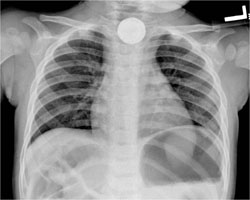 Yaritza Medina located her missing key-fob battery on a hospital X-ray, which showed it lodged in the throat of her 5-year-old daughter, Savannah.
Yaritza Medina located her missing key-fob battery on a hospital X-ray, which showed it lodged in the throat of her 5-year-old daughter, Savannah.
Only minutes after Savannah swallowed the battery, its electrical and chemical discharges began burning the tissue in her esophagus, and she started screaming. The family realized what had happened and rushed her to a Peninsula hospital. But doctors there didn’t have the equipment to remove it.
An ambulance rushed Savannah to CHKD, where a pediatric ear, nose and throat surgeon took her right into surgery and removed the battery. Unfortunately, her esophagus had already been severely burned.
“I am so grateful that we were close to CHKD when this happened,” Yaritza says. “I often wonder what would have happened if a pediatric hospital hadn’t been nearby.”
Button batteries – those shiny, coin-sized and smaller batteries that power countless devices – are more than a choking risk for children. When swallowed, they can burn through tissue and cause life-threatening injuries.
“A button battery is like a ticking time bomb,” says Dr. Cristina Baldassari, the ENT surgeon at CHKD who removed the battery from Savannah. “It can quickly erode the space between the esophagus and windpipe.”
 With many homes now teeming with electronic games and gear, button battery ingestions are on the rise. The National Capital Poison Center documents about 3,500 ingestions annually and reports 18 deaths since 1977. Children under 4 account for most fatalities and major injuries.
With many homes now teeming with electronic games and gear, button battery ingestions are on the rise. The National Capital Poison Center documents about 3,500 ingestions annually and reports 18 deaths since 1977. Children under 4 account for most fatalities and major injuries.
Dr. Baldassari says it’s impossible to know whether a button battery that has reached a child’s stomach will pass through without causing damage. It might get trapped in the intestinal wall, where it will burn through the tissue.
“The doctors in our emergency department know to send these children directly to surgery,” Dr. Baldassari said. “It is a true medical emergency.”
Fortunately, the battery Savannah swallowed was surgically removed before it burned a hole through her esophagus. Afterward, she was hydrated with intravenous fluids and placed on a liquid diet until her throat began to heal. After three days at CHKD, she was well enough to be discharged.
Savannah swallowed the battery last fall while her family was visiting relatives in Newport News. From her home in New York, her mom says Savannah’s burned esophagus has been monitored by doctors there, and she hopes the scars will fade with time.
“Overall, this has been an eye-opening experience for us as young parents,” Yaritza says. “We hope our story will help raise awareness about the danger that button batteries pose.”
Dr. Baldassari practices with EVMS’s ENT Group at CHKD.
This story was featured in the Winter 2012 issue of KidStuff, a publication of Children's Hospital of The King's Daughters. Click to read more patients' stories.